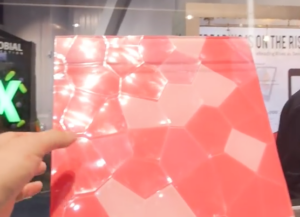New EPH tile will open up the architecture market for E InkAnother key player in the display space that did not make it to ISE was Taiwan-based E Ink (although it’s partner for large area displays, GDS, did! – Man. Ed. – GDS Concentrates on Colour). We sat down with Giovanni Mancini, head of global marketing for the company, and he gave us the 30,000 foot briefing of where E Ink is heading in this space.
Mancini started with news of a new display development kit product announcement, with component partner Visionect. The company supplies peripheral components and software to create turnkey ePaper signs. The group is targeting the signage integrator market, looking for those working in areas of business, traffic and public safety, retail, healthcare and education signage. It now offers a development kit that includes battery power and wireless (Wi-Fi and cell) connectivity, calling the products Smart Digital Signs and Kiosks.
Visionect’s kits work with both 9.7″ and 13.1″ diagonal ePaper displays. Supported resolutions include 1200 x 825 and 1600 x 1200, respectively, both with 16 levels of greyscale. The group also added web browser support.
Beyond the partnership announcement, Mancini told us – in traditional displays – the company is working as four different business units at different stages of development in the pipeline. That includes the rather mature EBR (eBook Reader) market; standard digital signs; shelf labels; hybrid and ruggedised (passive) signs used in petrol stations (made by partner GDS, under the “eTela” name); plus mobile and wearables, which includes watches and smartphone cases. As an example, Oaxis of Japan makes iPhone and Galaxy S series cases with embedded E Ink displays.
In the booth, E Ink was showing its shelf label system offering the advantage of very low (battery) power that can last the life of the sign and is unaffected by temperature swings. Another big bonus is daylight readability.
Mancini sees display upside in all markets that are maturing at different rates. For example, he told us that, in the shelf label space, E Ink sold 10 million units in 2013 and 20 million in 2014, with expected growth at the same rate for 2015.
At CES, E Ink introduced its Prism technology (we took a video, at http://tinyurl.com/l7pbneh) that brings the EPH technology out of the classical display space and into the architecture market. Rather than focusing on information display, these ‘screens’ are used to create an ambient experience through motion and colour when attached to the interior of buildings. “It takes the technology into a whole new space, with a completely different value proposition”, said Mancini. Prism was not as prevalent in the smaller DSE booth but the group was sure to bring it to the attention of those at the show as a horizon technology – we agree.

